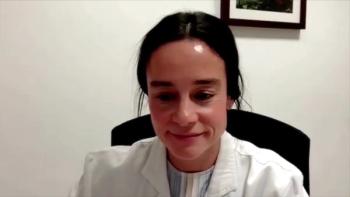
Teleophthalmology Reduces Rates of Vision Loss, Improves Access to Care
Teleophthalmology not only improves access to care and lowers the cost of care, but it can reduce rates of vision loss for patients with type 2 diabetes, said Parisa Emami-Naeni, MD, MPH, assistant professor of ophthalmology at University of California, Davis, and vitreoretinal surgeon and uveitis specialist at UC Davis Eye Center.
Teleophthalmology not only improves access to care and lowers the cost of care, but it can reduce rates of vision loss for patients with type 2 diabetes, said Parisa Emami-Naeni, MD, MPH, assistant professor of ophthalmology at University of California, Davis, and vitreoretinal surgeon and uveitis specialist at UC Davis Eye Center.
Transcript
Your research has found that remote retinal imaging use increased from 2011 to 2020, but payments for remote imaging declined. Why is there this disconnect?
We found that over the past 10 years, the number of teleophthalmology claims increased by more than 3-fold. However, as you mentioned, reimbursements have declined over time. Loss of insurance coverage and bundling of various services pay a role. A previous study by my coauthor and collaborator Dr Glenn Yiu showed that less than half of the teleophthalmology charges at a single university setting are paid by insurance. And most denials indicated that remote eye screening is not a covered benefit. Also, there are 3 different CPT [Current Procedural Terminology] codes that are commonly used for teleophthalmology services, and some of these codes are denied more often than others, which shows the confusing landscape for these codes and reimbursements.
What is the importance of expanding coverage for remote retinal imaging?
We know that the guidelines from the American Academy of Ophthalmology and American Diabetes Association recommend that any individual with type 2 diabetes should undergo an eye exam—a dilated eye exam—soon after diagnosis of diabetes and annually afterwards. However, we know that only less than 50% of diabetic individuals undergo an eye exam within 1 year of diagnosis of diabetes. This would increase their risk of severe complications of diabetes and vision loss among these individuals.
Teleophthalmology has [been] shown to lower the cost of care and increase access to an eye exam in remote areas or rural areas. Diabetic individuals can undergo retinal imaging at their primary care visits or endocrinologist office without even having to go to an ophthalmologist office. This will remove access issues and improve rates of eye examinations among these individuals and will decrease the complications in these individuals. Moreover, in our study, we showed that individuals [who] will undergo remote eye imaging can access these services at the time of diagnosis of diabetes, hence timely access to eye care. So, these services are very important in reducing greater complications and reducing rates of vision loss among diabetic individuals.
Newsletter
Stay ahead of policy, cost, and value—subscribe to AJMC for expert insights at the intersection of clinical care and health economics.








































